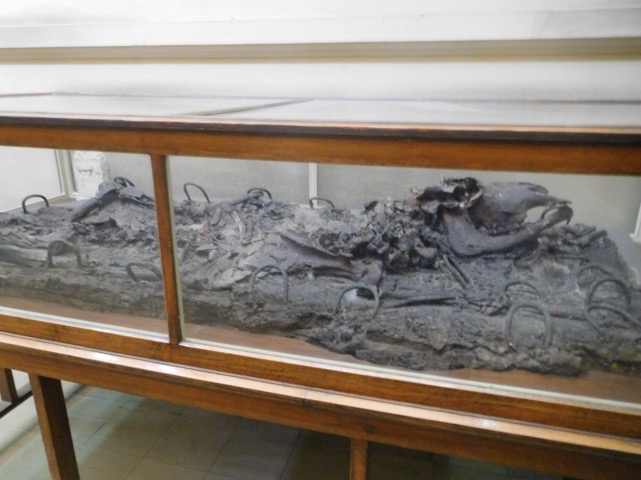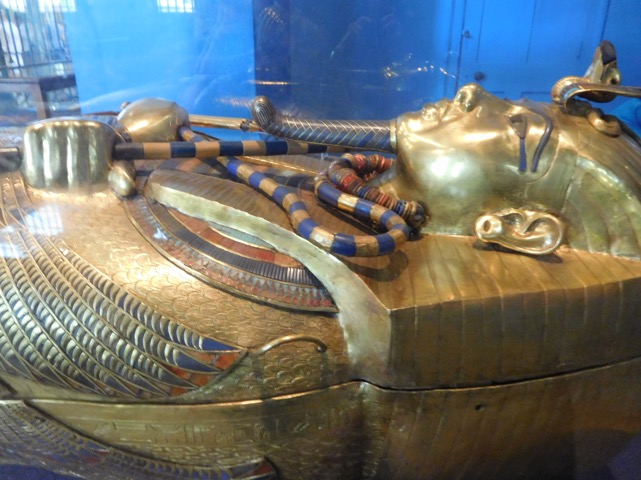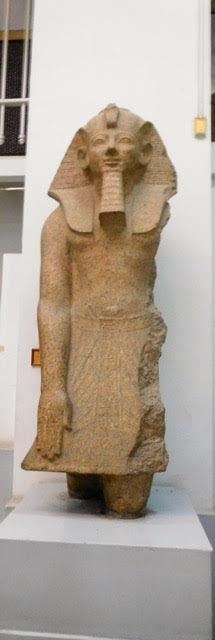First off, Cairo, head city of Egypt, is various shades of tan. All the buildings and the deserts are the same color and the only color almost to monotony. It is dust and sand at its most elegant and it is everywhere. My white hair even took on a tan tint. Then the heat grasps your lungs in a choke hold, and your eyes begin to water from the pollution. The streets are jammed bumper to bumper no matter what the season, the climate, the activity, the need. It’s just life in this historic city, so live with it. Furthermore, it’s just plain hot, so best to wrap self in scarves to catch any hope of a breeze while one wonders how all the Muslim women can stay wrapped head to toe in often heavy and mostly beautiful to elaborate fabrics and head scarves that mark their faith. None wear hats or caps, having been born blessed, I guess, with the olive colored skin that doesn’t burn and many dictates of their faith about what body part can be exposed.
And yet, way off in the distance if you squint in the sun, you might see three triangles, faintly at times, but it kicks in your heart that, hay, those are the Pyramids and I’m in Egypt, the origin of Biblical and the oldest histories on this earth, with Pharaohs and Cleopatras and hieroglyphics and the Nile housing crocodiles and tall stately palm trees, bull rushes and papyrus (stripped and beaten into the first ever paper on which men and women could write and or make pictures) and the land of Egypt played a tremendous part in the Christian faith’s beginnings as well as the Old Testaments preparation for the coming of the Messiah. Think Abraham in the Sinai desert. Think Moses on Mt. Sinai. Here is the land of Moses. Think the Holy Family were refugees here to escape Herod’s vengeance. Here, too, began the Orthodox and Coptic churches and the original monastery (St. Augustine) which facilitated desert fathers.
Here also are enormous Mosques where the call goes out five times a day to remember God is Great and all praise be to Him. Probably one of the most emotional moments of my whole trip to the Middle East was at the end of the day on which we visited the Pyramids and Memphis. It was about 5 something in the afternoon, and we were taking selfies at The Sphinx, far away from the confines of Cairo out in the desert, the sun fading, the tourist camels groaning as their day’s work ended, the wind offering up a breeze. I wrapped up in a long scarf (a way to keep the sun at bay) and all of a sudden I heard the 5 p.m. call to prayer and it was all around me, like a whirlwind, from neighborhood to neighborhood, from downtown to out of town, circling from east to west to north to south as the air became a chorus of calls, all in unison from the various towers on the mosques, a true symphony formed by the blending of different voices in the same chant and somehow I felt honored to be in that spot, comforted that a faith could be so together, so united, so everywhere.
One begins to respect the fidelity of the Muslims and the beauty of their appearances, the men often in the long Thawb, an ankle length robe, usually white, gray or brown, their heads wrapped in scarves like soft bowls; the women in Hijab that is often black but can be other colors, depending on the sect to which they are attached and it doesn’t matter if they are on the beach or in the markets or greeting visitors in the home. It is their dress. One rarely encounters Jews in these parts. And yet, there is so much history, it is everywhere and in everything that is going on. It’s like dipping a tiny paper cup into the sea and hoping to drink it dry. You can’t learn it all in a day. Like the strange ornate boxes built on special scaffolds around the city to satisfy a popular craze of breeding pigeons. They are all over the city and a coveted meal is grilled pigeon.
So our first excursion led by our Egyptologist guide Ramez was a trip to the enormous Egyptian Museum of History that sits right behind the Ritz Carlton Hotel, which is close to Thahir Square where the Arab spring violence occurred two years ago and a new government was elected as the military was kicked out. There is always a stir about many things in this city of 22 million residents. In fact, if someone says you look like a cow, it is a compliment – Goddess Hathor had a passion for cows. Few things are considered as beautiful as a cows long eyelashes. So a cow is a thing of beauty. That’s encouraging.
As we wandered through the museum to get our minds grounded in where we are and why it has come to be what it is today, I learned that even in those days before Christ there were slaves, olive skin and black slaves working with Nubian slaves rowing giant ships, working in the fields, helping men to succeed through 30 dynasties and three kingdoms: Old, Middle and New. From the very first kingdoms in 2600-2800 BC, Egypt had the power but it wasn’t until the Middle Kingdom, that Biblical heroes like Abraham and Joseph appeared, when Pharaoh had strange dreams of seven skinny cows, seven proper cows, and seven years of famine. and ended up with the 10 plagues sent by God so Pharaoh got the point that there was a God higher and more powerful than him. It took the parting of the Red Sea down south to finally convince him that God wins. Constructing Pyramids with blocks bigger than elevators preceded Abraham by 500 years, so he was not involved, but there were slaves, and they are obvious in the art that survives. Nubians were portrayed with protruding lips and flaring noses. Some made it to powerful leadership positions, even Pharaohs, and for this reason they are subjects of statues like other royalty such as Amenemhat III who saw those dreams which Joseph interpreted.
There was even a female king, Hatshepsut, who dressed like a male king because men didn’t like the idea of women ruling. She was daughter of King Amon who died and so she took over even though women were not allowed to be Kings. She led cultural, not military campaigns and was buried like other male Kings. Royalty was passed through the females of the family, a royal mom required, so often concubines had to marry the Queen’s daughters to obtain royalty. Marriages were definitely arranged by Mom. On the other hand, Kings wore spit fire cobras on their tall hat/crowns and if someone challenged the King his cobra would spit fire on the enemy and turn him into ashes. So one didn’t cross the man with the spit fire cobra unless you had a better snake. Only Moses achieved that when confronting the Pharaoh. In that moment recorded, Moses threw down his cane since Pharaoh was not cooperating. Moses’ stick became a snake and his stick snake ate up a multitude of snakes from the Cobra goddess’ wand who protected the Pharaoh.
Viewing the well preserved mummies was a bit depressing since whats left over from life, if stored properly, is rather ugly and hard to look at, even the queens and children, and all were extremely bone thin. It makes humanity seem so futile if we don’t cultivate our hearts and souls that go on beyond death. The Egyptians also mummified their pets, and there were examples of these in a special room, the most difficult to see was that of the cow, but rabbits, dogs, birds, etc. all were mummified. Easier on the eye were the wooden coffins of the wealthy decorated with pictographs and hieroglyphics, the ones we expect to see when exhibitions of Egyptian art tour the world. King Tut’s golden headdress and some fantastic animal beds got my attention. As did the sort of Maryoshka (Russian doll) affect – the wealthiest kings and pharaohs wanted to be preserved forever and so they put the wrapped body first in the ornate box we associate with Egyptian death, then that is put in another larger one, and then the larger one is put in a box about the size of a doghouse (highly decorated in gold and hieroglyphics ) and the doghouse was put in something the size of a shed, and then the shed was put inside a box the size of a one car garage. And it could go on and on. These were found in the tombs, all for the glory of having one’s body stay in tact. I don’t think it worked.












